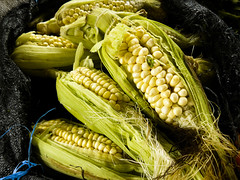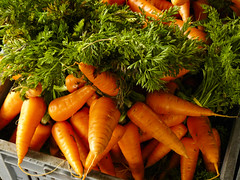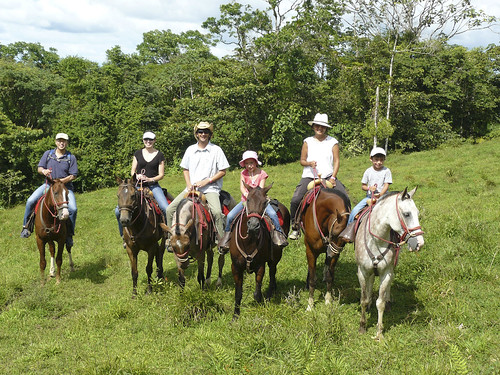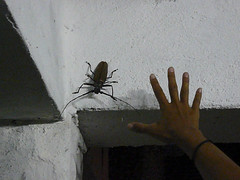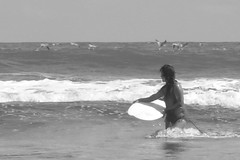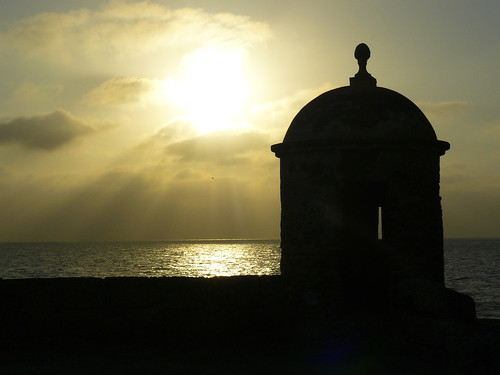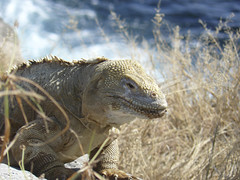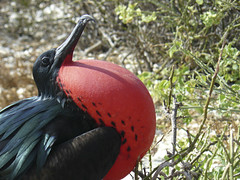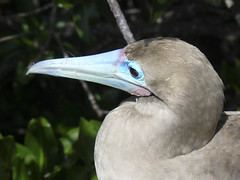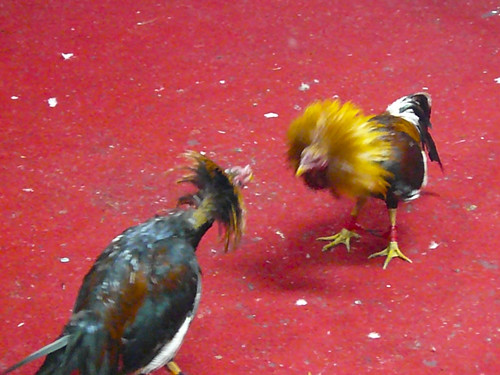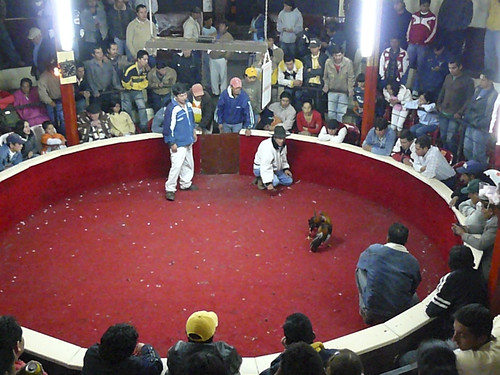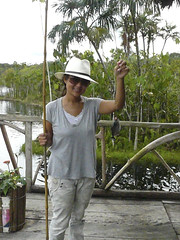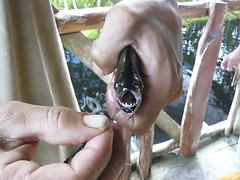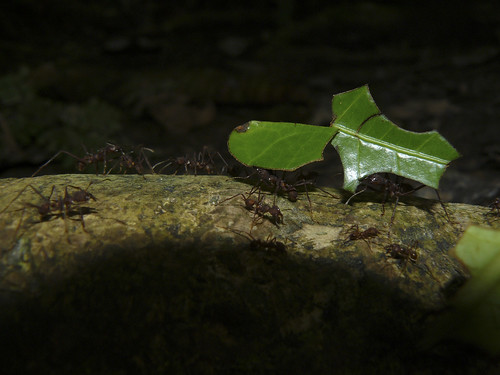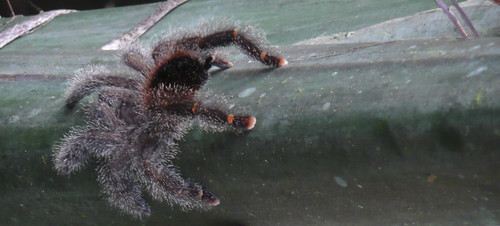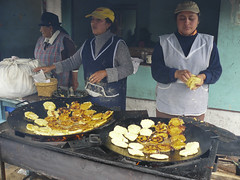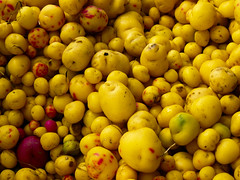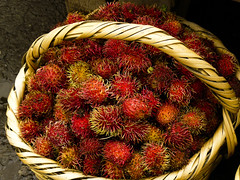
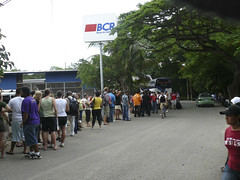
Over the last year we’ve been to close to 40 different countries. Entering the country by plane, bus, car or foot, customs and immigration in most countries have been hassle-free, and expedient. This is not the case at Penas Blancas, the border between Costa Rica and Nicaragua. We spent two hours waiting in line just to leave Costa Rica–I guess the customs officials were on lunch break. The Nicaraguan side only took about 20 minutes. We were lucky, though, as Hedda & Michael crossed at Penas Blancas the next day, their wait was 2.5 hours in Costa Rica AND 2 hours in Nicaragua.
border crossing
July 12th, 2008olive ridley sea turtles
July 10th, 2008In search of sea turtles nesting, Mike and I caught a bus to Samara from Nicoya. There are several nesting beaches on the Nicoya Peninsula where turtles come to lay their eggs. The best time is during the “arribadas” when thousands of olive ridley sea turtles make their way to the shore. So many turtles are nesting at the same time, it’s possible a turtle might dig up the nest of another turtle because the beach is full of eggs. The arriabadas occur between July and November, but it’s about being lucky, as no one can predict when this will happen.
 On a typical night between July and November a few turtles may come to nest, not thousands. Our tour took us to Playa Camaronal beach where four species of sea turtles are known to nest: olive ridley, hawksbill, leatherback and black turtle. Any sort of bright light will keep the turtles from coming ashore, so from 8pm to 9pm we combed the beach in complete darkness with out finding even one turtle. Our group was starting to give up hope of seeing a turtle, but our guide persevered. Finally, at 10pm, a teardrop shaped olive ridley turtle came ashore, and began her nesting ritual.
On a typical night between July and November a few turtles may come to nest, not thousands. Our tour took us to Playa Camaronal beach where four species of sea turtles are known to nest: olive ridley, hawksbill, leatherback and black turtle. Any sort of bright light will keep the turtles from coming ashore, so from 8pm to 9pm we combed the beach in complete darkness with out finding even one turtle. Our group was starting to give up hope of seeing a turtle, but our guide persevered. Finally, at 10pm, a teardrop shaped olive ridley turtle came ashore, and began her nesting ritual.
All turtles instinctively know where to lay their eggs–returning thousands of miles to the exact beach where they were born. The olive ridley laboriously makes her way up the beach to lay her eggs. She then uses her hind flippers to scoop out an appropriate sized hole for her eggs. Once this is completed, any where from 100-130 ping pong-sized eggs are laid. Again using her hind legs, she covers and neatly buries the eggs. She then disappears back into the ocean. The entire process lasts about one hour, and it’s pretty amazing to watch.
family matters…
July 10th, 2008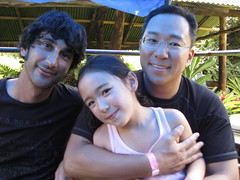
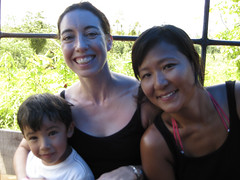
The week in Costa Rica with my brother and his family just flew by…But not without a few things that I can’t help but find funny. And I want to share them…
1. I’ve heard teenage kids sometimes call their parent by their first name as sort of a rebellious/ I’m independent kind-of-thing, but I’ve never heard a 7 and 5 year old do it. Kyra and Aiden were a bit confused by the fact that there are two “Mike’s”. And on many occasions last week, this led them to call their dad, “Mike,” rather than “dad”. I was reassured that this was the first time it’s ever happened, but personally, I found it really funny.
2. If you have been reading our blog this last year, you’ll know that I just learned how to swim. What you might not know is that non-swimmers run in my family. My dad is a great swimmer, but my brother and my mom aren’t. Now, what’s funny about this is that my brother’s kids are swimmers. Kyra is on the swim team, and Aiden plans to join next year. Kyra knows all the strokes, and they can both swim for hours in the pool. Which brings me to the point…Kyra and Aiden made endless jokes and demonstrated how my brother(their dad) swims doggie paddle!
no time for the weary in Costa Rica
July 4th, 2008From Santa Catalina in Panama, it took us two days of buses to reach San Jose, Costa Rica where we met Mike, Rachel, Kyra and Aiden. We drove from the airport out to the La Fortuna to tour around the Volcano Arenal for three days. In those three days, we went zip-lining above the canopy of the rainforest, horse back riding where we spotted toucans, sloths and snakes, and canyoning, repelling down cliffs and waterfalls.
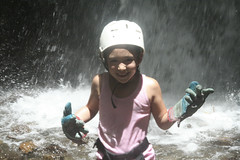
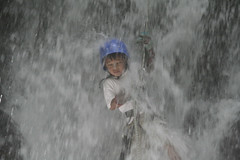
It’s been a year and half since we’ve seen my brother and his family. Kyra and Aiden have grown up to be wonderful little kids with big hearts and a strong sense of adventure. They were fearless on all of our activities. They loved all of them equally, saying “it was awesome.” Really amazing for only being 7 and 5 years old.
It was a busy three days, but since then we’ve driven north to Playa Conchal where there is little to do, but sit by the pool enjoying refreshing strawberry daquiris.
Today is the 4th of July and it’s nice to be here with family…it also makes me think about when my brother and I were kids…to celebrate independence day, we would light sparklers and race each other around the house as many times as we could before the sparklers would go out. Maybe I’ll see if my brother is up for the challenge tonight…
snorkeling in Coiba
July 3rd, 2008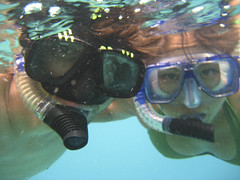
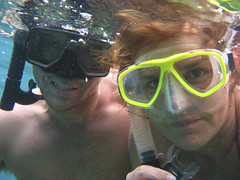
About an hour by boat from the Santa Catalina is Coiba Island, a former penal colony between 1919-2004. Since it’s closure as a prison, the island has been declared a world heritage site, due to its many plants and animals that are endemic to the island. We spent the day snorkeling with sea turtles, white tipped sharks and other amazing underwater life. This was some of the best snorkeling we have seen.
what if…
July 3rd, 2008Santa Catalina
July 3rd, 2008With Michael and Hedda, Mike and I ended up in a highly enviable position for anyone who might surf. Of course, we don’t but got to see first hand what it’s like to be at a prime surf location. Santa Catalina is pretty rustic with no “real” hotels, and very few restaurants, but people come for the waves. We spent 4 nights enjoying the unspoiled beaches. Michael did some surfing, and even spent a day teaching Mike and I how to surf. It was a blast– although not exactly as easy as Michael makes it look.
Panama Canal
July 3rd, 2008 From Cartagena, we (Mike, Michael and Hedda) flew to Panama City to see an engineering wonder of the world, the Panama Canal. The 48 mile canal connects the Atlantic and Pacific Ocean, eliminating the need to travel an additional 8000 miles to round Cape Horn (the southern point of South America). Opened in 1914, the canal continues to play an ever increasing role in shipping– expansion plans are underway to increase the capacity of the Panama Canal.
From Cartagena, we (Mike, Michael and Hedda) flew to Panama City to see an engineering wonder of the world, the Panama Canal. The 48 mile canal connects the Atlantic and Pacific Ocean, eliminating the need to travel an additional 8000 miles to round Cape Horn (the southern point of South America). Opened in 1914, the canal continues to play an ever increasing role in shipping– expansion plans are underway to increase the capacity of the Panama Canal.
Aside from visiting the Panama Canal, there isn’t a whole lot to do in Panama City except catch up on newly released movies, eat fast food and visit the mall– and we did all of the above.
Colombia
June 21st, 2008Colombia wasn’t exactly what we thought it would be. No paramilitary guerillas, no drug trafficking and no kidnappings. So we had to find other ways to amuse ourselves. Luckily Cartagena has lots of good food, good music and good views. It turned out to be a very relaxing place to spend our last week in South America.
Cartagena, Colombia
June 21st, 2008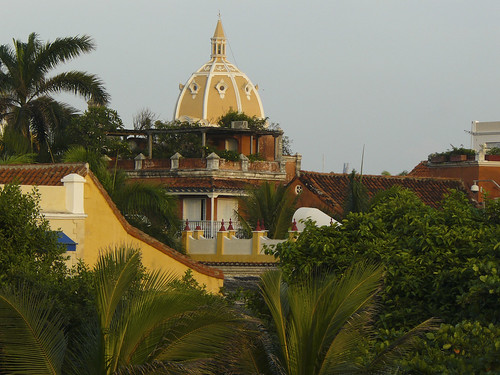
We met up with Hedda and Michael in Quito after our Galapagos trip. From there, the four of us flew to Cartagena, Colombia to explore the old colonial city. My first impression of Cartagena is that it is HOT and HUMID. Eventhough it’s a coastal city, it doesn’t get much relief from the winds off the Carribean. By 9am, it’s 90 degrees with 90% humidity, and by 11am you wish you never left the comforts of your air conditioned room…
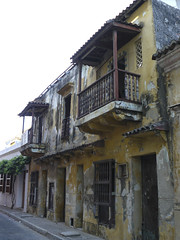
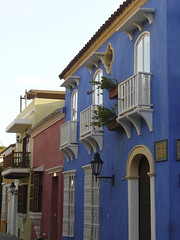
Much of the old city is undergoing restoration. New hotels, condos, private homes, etc. marks a sharp contrast between the old and the new. Although it seems an obvious choice…I´m torn between the dirty charm of the old, and the prefect quaintness of the new. Every run-down building tells the story of a past splendor when Cartagena was under colonial rule (from 1533-1811).
the Galapagos Islands
June 19th, 2008Our Galapagos Island trip was amazing. There are animal species that are endemic to the islands, and for that reason makes the Galapagos special. We stayed on board of a 100 ft. yacht with 13 other guests. The weather was perfect.
Each day we visited a different island, snorkeled, and hiked on the island for a few hours. On the island of Santa Fe we went in search of the land iguanas, in the mangroves of Santa Cruz we went to see the sea turtles, on Genovesa Island we saw the blue and red-footed boobie, the nazca boobie and the frigate birds. The male frigate bird spends his time building a nest and inflates his red sack in an attempt to attract a mate. During our hike one male frigate swooped down and pecked Mike on the head–probably mistaking his shiny dark hair for twigs that would be a good addition for his nest. At Sullivan Bay on Santiago Island we walked on lava flow only 100 years old. And we visited the giant tortoises on Santa Cruz.
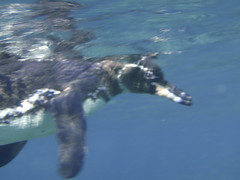 My favorite part was snorkeling and watching all the underwater sea life. We went swimming with the penguins, sea lions, tons of different fish and a white tipped shark, which we followed until it double backed on us!
My favorite part was snorkeling and watching all the underwater sea life. We went swimming with the penguins, sea lions, tons of different fish and a white tipped shark, which we followed until it double backed on us!
The Galapagos penguins would swim around diving down, then come back up for air. Once it stopped right in front of me, looked into my eyes pondering my existence, then instinct kicked in and off it went in chase of a meal. Sad to say, though, they aren’t so skilled at catching fish. Even with huge schools of fish, the penguins didn’t have much success– chasing the fish back and forth, back and forth, but missing each time. I wonder if they go hungry most days.
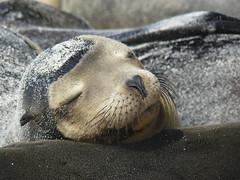 Unlike the penguins, I did see a bird dive into the water, and with amazing accuracy catch a fish. Pretty amazing to see what goes on below the surface of the water…the bird (sorry, I’m not sure what kind it was) dove down about 12 feet into a school of fish, there was a small commotion of water, and bang, it got a fish. And as quickly as it dove into the water, it ascended nearly as fast out of the water.
Unlike the penguins, I did see a bird dive into the water, and with amazing accuracy catch a fish. Pretty amazing to see what goes on below the surface of the water…the bird (sorry, I’m not sure what kind it was) dove down about 12 feet into a school of fish, there was a small commotion of water, and bang, it got a fish. And as quickly as it dove into the water, it ascended nearly as fast out of the water.
The sea lions are also fun to snorkel with. Slow as they are on land, underwater they jet past like a bullet, swimming circles around us. They are also much larger than the penguins, so when they stop abruptly in the water to stare, it’s a little alarming. Lucky for us though, the sea lions aren’t bothered with people snorkeling in their waters.
bizcoches
June 10th, 2008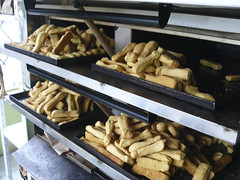 On the way to and from Otavalo, we stopped in Cayambe, a little town famous for bizcoches. Literally the entire town bakes these little biscuits, making it difficult to decide which place to stop at. The bizcoches are traditionally eaten with queso de hoja–sounds strange, but the biscuits are a bit dry, so the string cheese helps.
On the way to and from Otavalo, we stopped in Cayambe, a little town famous for bizcoches. Literally the entire town bakes these little biscuits, making it difficult to decide which place to stop at. The bizcoches are traditionally eaten with queso de hoja–sounds strange, but the biscuits are a bit dry, so the string cheese helps.
Otavalo market
June 10th, 2008Considered one of the biggest handicraft markets in all of South America, we decided to take a ride north of Quito to check out Otavalo. Market day in Otavalo is on Saturday and there are four different market areas– handicrafts or souvenir, produce, the large animal market and the small animal market. The whole town participates, everyone is selling something, everywhere.
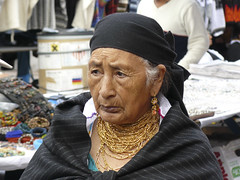
The traditional Ecuadorian women in Otavalo wear a lacey blouse, wool skirt cinched with a decorative woven belt, plait their hair in a woven band, wear a wool shawl around their shoulders or on their head. They didn’t wear fedoras and velour skirts like the women in Saquisili south of Quito, but they did wear gold necklaces. Oh, do they like these necklaces. We found a few vendors selling these necklaces, and the tables were crowded with Ecuadorian women looking to add to their collection. These multi-string necklaces of glass beads filled with gold are made from varying qualities. The color of the gold and the smaller the bead, the more expensive. The necklaces are said to last 15 years, I bought one so I in 15 years I´ll let you know if mine is still good…
Otavalo cockfights
June 9th, 2008Saturday night is cockfighting night in Otavalo. It’s quite an unusual spectacle, and although illegal in the States, it is still a very big part of Ecuadorian culture. About 100 people, mostly men, but a decent number of families crowded into a small stadium. We arrived early and saw some of the “pre-game” show, so to speak. The owners would proudly place their roosters on a big table to display them to the other contestants. They would be inspected, weighed and evaluated to determine who would fight who and what the odds would be. Eventually, when everything was set, the roosters touch beaks (seriously) and the fights began. It wasn’t nearly as gruesome as we had feared. The roosters do smack each other around, but spend most of the time tangled up, just like regular boxers. Unfortunately for the roosters, they have these sort of spikes taped to their feet, so when one of them jumps up and kicks, thats usually when the knockout blow comes. When a rooster goes down, the referee gives him the version of a 10 count by holding him up by his wings and seeing if he can stand on his own. 3 tries and he’s out. Luckily we didn’t see any real carnage, mostly a few stunned and scraped up roosters and a few very angry owners since you have to put up $100 to enter and you double your money if you win.
You should see the one that got away
June 9th, 2008We spent the afternoon piranha fishing, or more accurately, piranha feeding, as less than 10 seconds after the bait hit the water, it was devoured. Oddly enough, they didn’t seem to want anything to do with the people swimming a few yards away. Lucky for them, because these guys have some teeth on them. Christine proved to be the best fisherman in the group, reeling in 6. 2 were too small, but we had the other 4 for dinner.
Leafcutter ants
June 8th, 2008These little guys were all over the rainforest. Every once and a while we would find a line of ants stretching for hundreds of feet. They would be carrying leaves back to their nest from the top of huge trees. Thousands of them making this huge journey, over and over again.
[youtube]http://www.youtube.com/watch?v=1EyX_fI0ENY[/youtube]
The Amazon
June 6th, 2008Last week we headed off to the Amazon Basin in Ecuador. Ever since we left Africa, we’ve been missing spending our days watching animals, but since 1/3 of all species of wildlife live in the Amazon Rainforest, we figured we would make up for lost time. What we didn’t take into account is that the majority of these species are birds, and fish, and insects. Nothing against the little creatures of the world, but a bad day in Africa meant we only saw a few dozen elephants, giraffes and zebras. A good day in the rainforest means you see 5 birds, a frog and if you are lucky, a monkey.
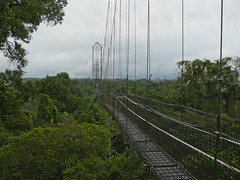 Birds are quite a big deal in the Amazon. The are 1600 different kinds in Ecuador and there were 600 alone in the area of our lodge. Unfortunately for us, there are few things we are less into than spending the day looking for birds. One of them is getting up at 5AM to look for birds. The other is getting up at 5AM to look for birds, and there being no birds to look at. This was the case the first few mornings as it was overcast and not good for bird watching. Oddly enough, when it was too sunny, that wasn’t a good time for the birds either. We did get to climb this cool canopy bridge to not see any birds at 5AM though.
Birds are quite a big deal in the Amazon. The are 1600 different kinds in Ecuador and there were 600 alone in the area of our lodge. Unfortunately for us, there are few things we are less into than spending the day looking for birds. One of them is getting up at 5AM to look for birds. The other is getting up at 5AM to look for birds, and there being no birds to look at. This was the case the first few mornings as it was overcast and not good for bird watching. Oddly enough, when it was too sunny, that wasn’t a good time for the birds either. We did get to climb this cool canopy bridge to not see any birds at 5AM though.
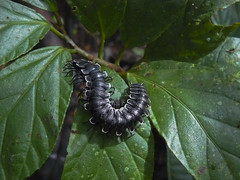 We quickly learned to adapt our expectations to our new environment. The Amazon rainforest is huge (2.1 million square miles), 40% of South America, and dense. So the wildlife that lives there has plenty of places to hide. We had to take notice of the small things. Sure it’s easy to spot an elephant. But finding a tiny insect or frog in the middle of the jungle is a lot harder. Our afternoon hikes were filled with learning about how the indigenous people in the jungle used the various types of plants and trees. We eventually did get to see some interesting birds…parrots, owls, toucans and vultures. We also saw a 3 toed sloth and a caiman, which is a South American crocodile. We just missed seeing an anaconda, and had to look jealously at another group’s pictures. Below is a tarantula that our guide found hiding in a tree.
We quickly learned to adapt our expectations to our new environment. The Amazon rainforest is huge (2.1 million square miles), 40% of South America, and dense. So the wildlife that lives there has plenty of places to hide. We had to take notice of the small things. Sure it’s easy to spot an elephant. But finding a tiny insect or frog in the middle of the jungle is a lot harder. Our afternoon hikes were filled with learning about how the indigenous people in the jungle used the various types of plants and trees. We eventually did get to see some interesting birds…parrots, owls, toucans and vultures. We also saw a 3 toed sloth and a caiman, which is a South American crocodile. We just missed seeing an anaconda, and had to look jealously at another group’s pictures. Below is a tarantula that our guide found hiding in a tree.
more fried goodness…
June 2nd, 2008Saquisili market
June 2nd, 2008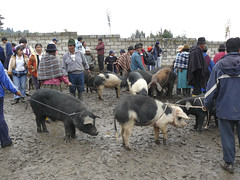 From Machu Picchu we headed back to Cuzco, and flew to Quito, which basically saved us about 3 days on a bus. Once in Quito, we rented a car and to do the Quilotoa circuit, the highlights include the Saquisili market and the Quiltoa crater, Cotopaxi volcano but also passing by the towns of Sigchos, Zumbahua, Tigua, Pujili, Chugchilan, and Latacunga.
From Machu Picchu we headed back to Cuzco, and flew to Quito, which basically saved us about 3 days on a bus. Once in Quito, we rented a car and to do the Quilotoa circuit, the highlights include the Saquisili market and the Quiltoa crater, Cotopaxi volcano but also passing by the towns of Sigchos, Zumbahua, Tigua, Pujili, Chugchilan, and Latacunga.
The Saquisili market onThursday mornings is jammed packed with locals selling everything from fruits, vegetables, grains, household goods and domestic animals. It rained the night before and on Thursday morning making the area a muddy mess, and the animals all a bit gnarly. The addition of farm animals to the market made for an exciting morning. We spoke to a few animal sellers to see what the going rate for their animals would be…an 8 month old pig was about $100, a cow $300, and a 15 year old llama $80 dollars.
